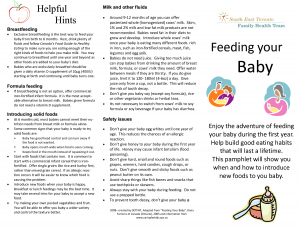I am so sorry for my rushed presentation last week. It didn’t want to hold too many people up after class since we all had finals coming up soon. I will use this forum here to explain some parts of the presentation that I didn’t have a chance to do earlier.
My original plan was to open the presentation up in another language, Cantonese. I wanted people to experience the feeling of not understanding anything at all. I choose breastfeeding because it is a topic that is easy to understand. Yet, as you may guess, without any pictures or diagrams, you would not have been able to understand what I was trying to convey to you. Once I would should the diagrams of how to breastfeed and when to breast feed, you would immediately know exactly what I was trying to say. (Here is a link to some really great pictorials: http://www.spring-nutrition.org/publications/training-materials/nigeria-community-and-facility-infant-and-young-child-feeding)
My point in doing this small experiment in the beginning is to show how effective pictures are. It seems that we lack the use of pictures for many health related issues. See the
pamphlet above. It is suppose to be informative but lack diagrams and pictures for people who are illiterate and non-English speakers to understand. If you recall the health literacy study that I brought up in class. This study provided a survey for adults with various backgrounds, including individuals in prisons. The survey assess 3 domains, clinical domain, prevention domain, and navigation of healthcare system. The clinical domain involved ability to fill out a patient information form correctly, understanding dosage of medication, and following a healthcare provider’s recommendation. The prevention domain refers to activities involving prevention of disease and managing health such as addressing signs and symptoms of health problems. Understanding of how eating and exercise can influence health. The last domain is understanding of how the healthcare system works such as your rights as a patient, what health insurance will and will not pay for. From this survey, “58% of Black and 66% of Hispanic adults exhibited “basic” or “below basic” health literacy, compared to only 28% of White adults.” This is a staggering number. Although there are many influences over health literary such as education level, but I feel that this is more reason for why we need more pictorial health materials so that more people can understand the health information that is being told to them.
In addition, the Delp and Jones study showed that pictorials enhanced the ability to recall and understand information as well as increasing adherence to the methods shown in the pictorials. This study gave 234 emergency room patients were either given instructions without pictures for managing lacerations or instructions with pictures. The study showed that not only were the instructions with pictures more likely to be read but also found that those with the instructions with pictures were more likely to do what what recommended in the instructions, about 77% compared to 54% respectively.
I am citing these studies to show just how effective pictorials can be to understanding health matters. This class is about birth and global health so I continued to see how this can be expanded broader, into the context of our class.
In Myanmar, an NGO initiated a community based safe motherhood initiative. They handed out pictorial handbook, similar to the one we saw from Dr. Sibily’s presentation, that addressed common signs and symptoms during pregnancies as well as antenatal care. The healthcare volunteers also held 3 day weekly sessions for 6 months and taught with the pictorial handbook. Overall, they saw an increase in health communication as well as health knowledge. Each cohort was given a pictorial kit that included the 5 dangers of pregnancies (ante partum hemorrhage, pre-eclamptic toxemia, prolonged labor, mal-presentation, and post partum hemorrhage). During the prenatal visits, the mothers were asked to bring this pictorial kit with them and the nurse would ask the mothers to explain each card to them. When the nurse would notice a misunderstanding, the nurse would correct the mistake before moving on to the next pictorial. This resulted in an increase from 8.9% to 34.2% between the first and 2nd antenatal visit as well as a 13% increase in delivery in a facility.
Powerpoint:
Sources:
Allen J. and Hector D. “Benefits of breastfeeding.” NSW Public Health Bulletin, 16.3 (2005): 42-26. Web. 3 December 2014.
Holtby, Mike. Ethnic Groups. 2013. Myanmar 2013. Web. 3 December 2014.
Houts, P., Doak C., Doak L., and Loscalzo M. “The Role of Pictures in Improving Health Communication: A Review of Research on Attention, Comprehension, Recall, and Adherence.” Patient Education and Counseling, 61.2 (2006): 173-90. Web. 4 December 2014.
Kutner M., Greenberg E., Jin Y., and Paulsen C. “The Health Literacy of America’s Adults: Results From the 2003 National Assessment of Adult Literacy (NCES 2006–483).” U.S. Department of Education. Washington, DC: National Center for Education Statistics. (2006). Web. 4 December 2014.
Matthews M., Walley R., Ward A., Akpaidem M., Williams P, and Umoh A. “Training traditional birth attendants in Nigeria-the pictorial method.” World Health Forum, 16.1 (1995): 409-414. Web. 4 December 2014.
Rahman A. and Anwar I. “Behavior Change Communications during Antenatal Visits Using Pictorial Cards Improves Institutional Delivery Rates: Evidence from Mathlab, Bangladesh.” International Journal of Tropical Disease & Health, 3.3 (2013): 242-256. Web. 4 December 2014.
Soe, Htoo H. and Somrongthong, R. “The effect of community based safe motherhood pictorial handbook health education intervention in Pa-Oh ethnic group, Myanmar.” Journal of Medicine and Medical Sciences, 2.10 (2011): 1171-1179. Web. 4 December 2014.
The Baby Friendly Initiative for all babies. UNICEF UK. Web. 3 December 2014.
SPRING (Strengthening Partnerships, Results, and Innovations in Nutrition Globally). USAID. Web. 3 December 2014.
Yaolan和识育儿百科. http://www.yaolan.com/zhishi/muruweiyang/
